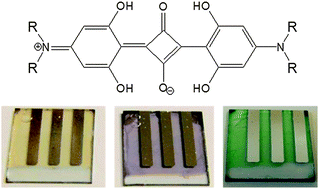Structure–property relationship of anilino-squaraines in organic solar cells†
Abstract
Soluble molecular semiconductors are a promising alternative to semiconducting polymers in the field of organic photovoltaics. Here, three custom-made symmetric 1,3-bis(N,N-alkylated-2,6-dihydroxy-anilino)squaraines containing systematic variations in their molecular structures are compared regarding their applicability as donor materials in bulk-heterojunction solar cells. The terminal substitution pattern of the squaraines is varied from cyclic over linear to branched including a stereogenic center. Single crystal structures are determined, and, in the case of chiral squaraine, unusual formation of stereoisomer co-crystals is revealed. The thin film absorbance spectra show characteristic signatures of H- and J-bands or hint at the formation of tautomers. The general feasibility of these model compounds for photovoltaic applications is studied by light-induced electron spin resonance spectroscopy. The impact of the different molecular substitution patterns on aggregation behavior and, consequently, their optoelectronic solid state properties including charge carrier mobility and finally the solar cell performance are investigated.


 Please wait while we load your content...
Please wait while we load your content...